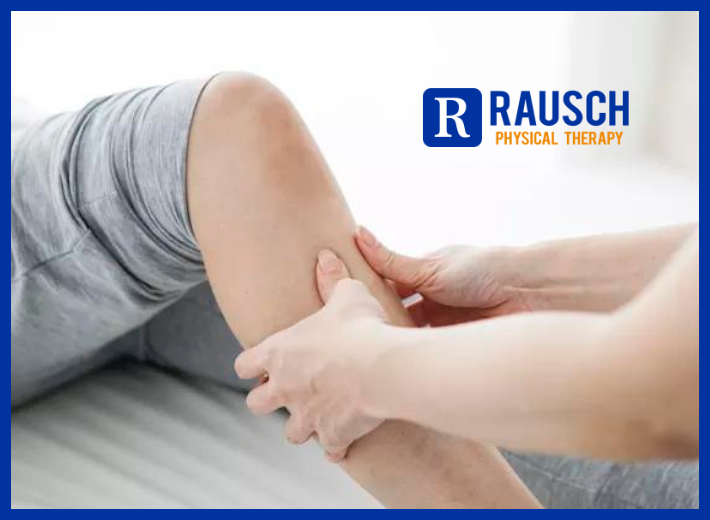When it comes to sports, staying healthy is just as important as playing hard. A serious injury can knock you out of the game for weeks—or even months—whether you’re a,
Exercising your Leg After a Broken Bone
October 1, 2022 4:04 pm / Category: Rausch Physical Therapy

A broken leg can take you out of your activities for months. Recovering depends on the type, location, and complexity of the fracture. The ideal recovery from a broken leg returns you to pre-injury leg function without any pain. You can get all the need to restore mobility and strength with a Rausch PT expert — and reduce the chance of injuries to supportive muscles with our Rx Massage. Read on to learn more about broken legs and tips to recover.
Whether a patient is a little kid, an active adult or a senior citizen, breaking a bone — particularly one in their leg — can knock them out of their regular routine for weeks or even months. As they heal, they’ll have to start the process of learning to walk after a broken leg.
That’s not a one-size-fits-all process. If you’re a patient who is learning to walk after a broken leg, you’ll find that you have to be very careful in determining the right pace: Go too aggressively and you might risk hurting yourself again, but go too gently and you might struggle to get back to full strength.
Your doctor or physical therapist can help you develop a plan that’s right for you and your specific situation, but here are a few general guidelines to keep in mind when you’re on the mend.
A Look at Leg Fractures
As Harvard Health Publishing explains, a fracture can happen to one of three major bones in the leg: There’s the femur, the formal name for the thighbone. Then there are the two lower leg bones, the tibia and the fibula. A doctor will diagnose a fracture with the use of an X-ray, which will also help determine the severity. Some cases of fracture involve multiple fragments, require surgery or even involve other complications like infection.
Not all leg fractures are alike, and a fracture in the femur will be slightly different from a fracture in the tibia or fibula. Here’s a closer look at how the fractures differ in each bone:
The femur is a strong bone and often takes significant force to break in a healthy person — think car accident or a fall from a great height. Children might break their femur from falling out of a tree or off the top of a slide. A person with a condition that weakens their bone strength (e.g. osteoporosis, cancer) could suffer a fracture from a lower-impact bump or fall.
When the femur is broken, Harvard Health Publishing notes, you’ll likely experience pain, swelling, tenderness, bruising in the thigh, an inability to bear weight and an inability to move the hip or knee on the affected side. If the fracture causes a break in the skin, you might see a visible portion of the fractured bone.
The American Academy of Orthopedic Surgeons notes that a broken femur often takes three to six months to heal.
About 75 to 85 percent of the time, a fracture of the tibia is accompanied by a fracture of the fibula. The tibia is the larger of the lower leg bones, whereas the fibula is the thin bone on the outer side that runs parallel to the tibia. Like the femur, they can be broken from high-impact trauma, but Harvard Health Publishing also notes that the tibia can be broken from low impact if the lower leg is bent or twisted above the ankle.
When you break your tibia and/or fibula, you will likely experience pain, swelling and tenderness just as you would with a fracture of the femur. You will also likely see a deformity of the lower leg and an abnormal alignment or positioning of the foot on the affected side.
According to the American Academy of Orthopedic Surgeons, a fracture of the tibia can take four to six months to heal.
Care for a Broken Leg
Ideally, you can avoid having to treat a fracture and learning to walk after a broken leg by reducing your risk of fracturing your bone in the first place. This is especially important for older adults, who are prone to osteoporosis.
The National Institutes of Health explains that it’s important to build and maintain bone density through exercise, as bone will respond to and get stronger from physical activity the same way that muscle does.
Weight-bearing exercises like walking, climbing stairs, dancing and playing tennis are good for increasing bone strength, and resistance training — such as lifting weights — builds muscle to support your bones. Additionally, you should do exercises like yoga to improve your balance and swimming or stretching to improve your flexibility.
But even with proper precautions, fractures still happen. When they do, it’s important that the leg is immobilized via a splint or cast to restrict the movement of the broken bone while it heals, per the Mayo Clinic. Crutches may be necessary to help you keep weight off the injured leg for six to eight weeks.
Another important part of the healing process, explains the American Academy of Orthopedic Surgeons, is pain management. Because a fracture can often be painful, doctors might recommend acetaminophen, nonsteroidal anti-inflammatory drugs (NSAIDs), gabapentinoids, muscle relaxants, opioids or topical pain medications. Be careful with opioids, as they are addictive — use them only as your doctor instructs.
Learning to Walk After a Broken Leg
While your leg returns to full strength, you will need to take care in learning to use it again. This process starts with the removal of the cast or splint that your doctor has you in. In some cases, according to the American Academy of Orthopedic Surgeons, your doctor will encourage you to put weight on the leg right after surgery, but in other situations, you need to wait for the fracture to heal.
When you start walking again, the Mayo Clinic explains, you might have stiffness or weakness in your leg. This makes sense — after all, you haven’t moved it or used it in a long time. You likely will have lost muscle strength in your leg.
In some cases, staying active is the best option for healing a broken leg. In the case of a broken fibula, Saint Alphonsus Rehabilitation Services recommends using a walking boot to stay mobile while your fracture heals. Physical activity like walking means there is less muscle atrophy, so you will have an advantage when you start engaging in physical therapy to bring the leg back to full strength.
The Mayo Clinic and the American Academy of Orthopedic Surgeons agree that physical therapy and rehab are important parts of learning to walk after a broken leg. Rehabilitation exercises prescribed by your doctor or physical therapist will reduce stiffness and help you achieve the mobility you have lost. Eventually, you will regain the muscle strength and flexibility you had before.
Regain strength. Reclaim your mobility. Keep doing what you love. Our physical therapy experts will evaluate your injury and customize a treatment plan that fits your needs. When it comes to your health, you have the option to request the best. Find our team at 949-276-5401 or meet us on our Facebook page.
Reference: [https://www.livestrong.com/article/380434-things-to-get-your-leg-to-full-strength-af er-you-broke-a-bone/]






